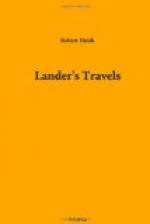In May 1797, Horneman repaired to London, where his appointment was sanctioned by the association, and having obtained a passport from the Directory, who then governed France, he visited Paris, and was introduced to some influential members of the National Institute. He reached Egypt in September, spent ten days at Alexandria, and set out for Cairo, to wait the departure of the Kashna caravan. The interval was employed in acquiring the language of the Mograben Arabs, a tribe bordering on Egypt. While he was at Cairo, intelligence was received of the landing of Buonaparte in that country, when the just indignation of the natives vented itself upon all Europeans, and, amongst others, on Horneman, who was arrested and confined in the castle. He was relieved upon the victorious entry of the French commander, who immediately set him at liberty, and very liberally offered him money, and every other supply which might contribute to the success of his mission.
It was not before the 5th September 1798, that Horneman could meet with a caravan proceeding to the westward, when he joined the one destined for Fezzan. The travellers soon passed the cultivated lands of Egypt, and entered on an expanse of sandy waste, such as the bottom of the ocean might exhibit, if the waters were to retire. This desert was covered with the fragments, as it were, of a petrified forest; large trunks, branches, twigs, and even pieces of bark, being scattered over it. Sometimes these stony remains were brought in as mistake for fuel. When the caravan halted for the night, each individual dug a hole in the sand, gathered a few sticks, and prepared his victuals after the African fashion of kouskous, soups, or puddings. Horneman, according to his European habits, at first employed the services of another, but finding himself thus exposed to contempt or suspicion, he soon followed the example of the rest, and became his own cook.
There are, as usual, oases in this immense waste. Ten days brought the caravan to Ummesogeir, a village situated upon a rock, with 120 inhabitants, who, separated by deserts, from the rest of the world, passed a peaceful and hospitable life, subsisting on dates, the chief produce of their arid and sterile soil.
Another day’s journey brought them to Siwah, a much more extensive oasis, the rocky border of which is estimated by Horneman to be fifty miles in circumference. It yields, with little culture, various descriptions of grain and vegetables; but its wealth consists chiefly in large gardens of dates, baskets of which fruit form here the standard of value. The government is vested in a very turbulent aristocracy, of about thirty chiefs, who meet in council in the vicinity of the town wall, and in the contests which frequently arise, make violent and sudden appeals to arms. The chief question in respect to Siwah is, whether it does or does not comprise the site of the celebrated shrine of Jupiter Ammon, that object of awful veneration




